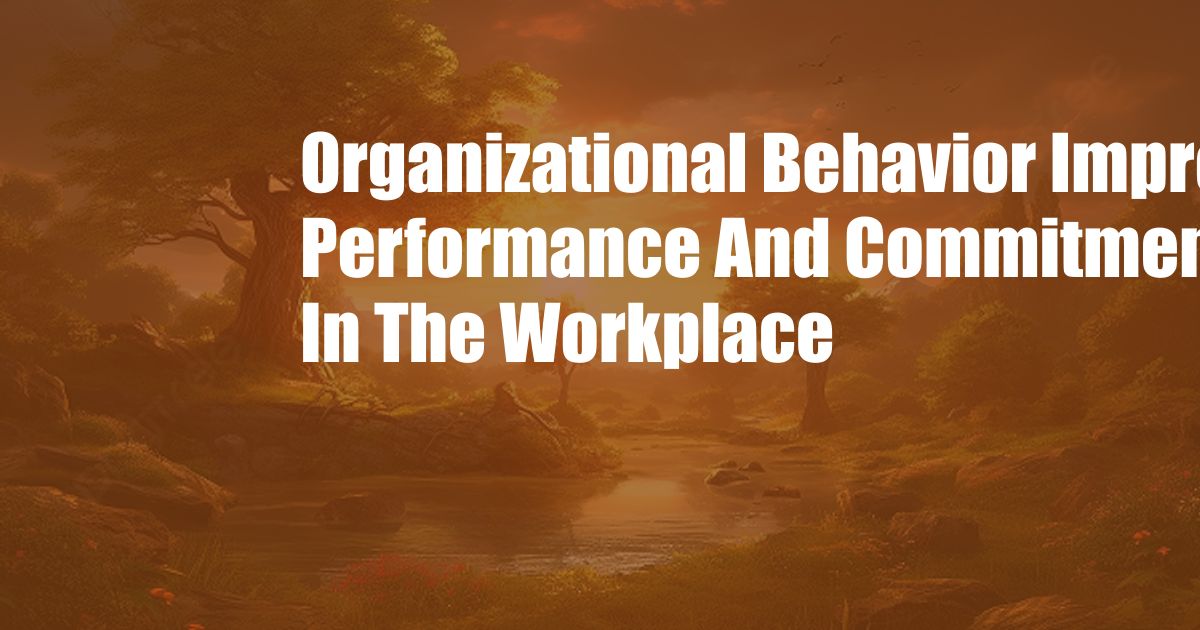
Organizational Behavior: Improving Performance and Commitment in the Workplace
In the backdrop of a vibrant corporate world, I recall a profound interaction with a seasoned executive. As she shared her insights on managing high-performing teams, she emphasized the paramount importance of understanding organizational behavior. Her words ignited a spark within me, fueling my curiosity to delve deeper into this captivating domain.
Organizational behavior unravels the intricate tapestry of human interactions within the workplace. It encompasses the study of employee attitudes, motivations, job satisfaction, and group dynamics. By understanding these fundamental aspects, organizations can foster a positive and thriving work environment that enhances performance and commitment.
Defining Organizational Behavior
Organizational behavior encompasses the study of human behavior in organizational settings. It explores how individuals and groups interact within the workplace, including their motivations, attitudes, and behaviors. This field of inquiry seeks to comprehend the factors that influence employee performance, job satisfaction, and organizational commitment.
The history of organizational behavior can be traced back to the early 20th century, with the emergence of scientific management and human relations approaches. These approaches emphasized the importance of understanding employee needs and motivations to improve workplace efficiency and productivity. Over time, organizational behavior has evolved into a multidisciplinary field, drawing insights from psychology, sociology, anthropology, and economics.
Keys to Improving Performance and Commitment
Enhancing organizational performance and commitment hinges on a comprehensive understanding of employee behavior. By fostering a positive and supportive work environment, organizations can cultivate a workforce that is engaged, motivated, and committed to achieving organizational goals. Here are some key factors that contribute to improved performance and commitment:
- Clear communication and expectations: Employees must have a clear understanding of their roles, responsibilities, and performance expectations. Open and transparent communication channels facilitate effective feedback and support.
- Recognition and rewards: Acknowledging and rewarding employee accomplishments motivates and reinforces positive behavior. Recognition programs foster a sense of appreciation and encourage employees to strive for excellence.
- Job satisfaction and engagement: Employees who find their work meaningful and engaging are more likely to be committed and productive. organizations should align individual goals with organizational objectives to enhance job satisfaction.
- Employee development and growth: Investing in employee development through training and career advancement opportunities demonstrates the organization’s commitment to their growth. This fosters loyalty and a sense of belonging.
- Positive work culture: A positive and supportive work culture promotes collaboration, innovation, and mutual respect. Employees who feel valued and respected are more likely to be engaged and committed to the organization.
Expert Advice and Tips
Drawing upon the insights of industry experts, I offer some practical tips for improving organizational behavior and fostering a high-performing and committed workforce:
- Empower employees: Empowering employees with autonomy and decision-making authority fosters a sense of ownership and responsibility. This encourages them to contribute their unique perspectives and ideas, driving innovation and progress.
- Encourage collaboration: Collaboration fosters knowledge sharing, innovation, and team-building. Create opportunities for employees to work together on projects and assignments, breaking down silos and promoting a sense of community.
- Provide regular feedback: Regular feedback helps employees understand their strengths and areas for improvement. Constructive feedback fosters growth and development, while positive feedback reinforces good work and motivates employees.
- Foster a positive work environment: A positive and inclusive work environment promotes employee well-being and productivity. Encourage open communication, celebrate diversity, and create a space where employees feel valued and respected.
- Embrace technology: Leverage technology to enhance communication, collaboration, and employee engagement. Technology can streamline processes, automate tasks, and provide employees with access to real-time information, empowering them to work more efficiently and effectively.
Frequently Asked Questions
Q: What are the benefits of understanding organizational behavior?
A: Understanding organizational behavior provides valuable insights into employee attitudes, motivations, and behaviors. This knowledge empowers organizations to create a positive work environment, improve performance, and foster employee commitment.
Q: How can organizations measure and evaluate organizational behavior?
A: Measuring and evaluating organizational behavior involves utilizing surveys, questionnaires, performance evaluations, and other data collection methods. This data can provide insights into employee satisfaction, motivation, and commitment levels.
Q: What are the latest trends in organizational behavior?
A: Current trends in organizational behavior include the increasing importance of employee well-being, the rise of remote work and flexible work arrangements, and the use of technology to enhance employee engagement and collaboration.
Conclusion: A Call to Action
Organizational behavior plays a pivotal role in driving performance, commitment, and the overall success of organizations. It is not merely a theoretical concept but a transformative tool that can empower organizations to create a thriving and productive work environment. By embracing the principles and practices of organizational behavior, organizations can unlock the full potential of their employees and achieve lasting success.
I encourage you to continue exploring the fascinating world of organizational behavior. Engage with resources, consult with experts, and apply these concepts within your own organization. By investing in your understanding of organizational behavior, you can cultivate a workplace where employees flourish, performance soars, and commitment thrives.